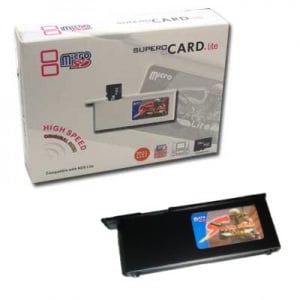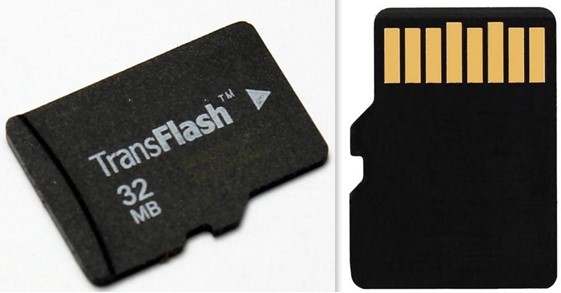Secure Digital Slot

This item Targus USB 2.0 Secure Digital Card Reader/Writer with Micro SD Slot (TGR-MSD500) Anker 2-in-1 USB 3.0 SD Card Reader for SDXC, SDHC, SD, MMC, RS-MMC, Micro SDXC, Micro SD, Micro SDHC Card and UHS-I Cards. Secure Digital (SD) is a flash memory memory card format used in portable devices, including digital cameras and handheld computers. SD cards are based on the older Multi Media Card (MMC) format, but most are physically slightly thicker than MMC cards. Meanwhile, other tablets tout the availability of a Micro Secure Digital (microSD) slot in addition to the built-in storage. These include the recently-announced Samsung Galaxy Tab 3 models, in 7. Secure Digital (SD) Cards. A Secure Digital (SD) card is a small non-volatile electronic memory device. Non-volatile is just another way to say it does not require power to retain data stored on it. Simply speaking, an SD card is like a really small cassette tape that can hold photos, music, or other computer files. The Integral USB 2.0 Single Slot SD Card Reader is a fast and convenient way of transferring data between any SD, SDHC SDXC Card and your PC or Mac. Simply insert your SD Card into the reader and then plug the reader into a USB port on your computer and view your files instantly.
History
In 1997, Siemens AG and SanDisk developed the MMC card using Toshiba's NAND-based flash memory. As it uses NAND based flash memory, it is much smaller in size than the IntelNOR-based memory; such as CompactFlash. Originally it used a 1-bit serial interface, but with the new architecture, now it can transfer 4 or 8 bits at a time.


After the release of MMC cards most of the portable music players started using MMC cards as primary storage. But the music industry was skeptical about the use of MMC, as MMCs would allow easy piracy of music. So, Toshiba added encryption hardware in existing MMC and named it Secured Digital or SD card. This allowed Digital Rights Management(DRM) for the music. Matsushita, SanDisk, and Toshiba jointly developed, next generation secure memory card called the SD Memory Card. SD cards provide both an SDMI-compliant (Secure Digital Music Initiative) high-level of copyright protection and high-density memory capacity. Today, in many areas, MMC are being replaced by SD cards. The only reason why some devices continue using MMCs are because of their comparative lower cost than SD cards.
Size
The size of a standard MMC card is 24 mm x 32 mm x 1.4 mm while that of a SD card is 24 mm × 32 mm × 2.1 mm. So from the size comparison, we can see that SD cards are much thicker than the MMC cards, 2.1 mm against 1.4 mm.
Interoperability
Because of the size similarity, MMC cards can be also used in the standard SD card slot, but the reverse is not true.
Storage Capacity
MMCs are currently available in sizes up to 4 GB and 8 GB models. As of September 2007, SD cards were available in sizes from 8 MB to 16 GB. A few companies have announced SD cards with 32 GB also.

Usage
Amongst digital cameras, companies that use SD cards include Canon, Epson, Casio, HP while Epson and some models of Nikon and Sony cameras use a MMC card and compact flash memory depending on the model. In Mobile phones, Nokia uses both MMCs and SD cards which vary according to the model. Samsung and Motorola phones use SD cards. Amongst gaming consoles, Nintendo Wii and Sony Playstation 3 use SD cards while Xbox 360 uses a memory unit.
Different versions
Apart from the standard MMC there are other versions available also. They are Reduced-Size MultiMediaCard (RS-MMC), dual voltage MMC card (DV-MMC), MMC plus, MMC mobile, MMC micro and MMC secure.
RS-MMC has a size of 24 mm × 18 mm × 1.4 mm. It was released in 2004. RS-MMCs are smaller MMCs and use a mechanical adapter to elongate the card. It can be used in any MMC (or SD) slot and they are currently available in size up to 2 GB.
DV-MMC cards can operate at 1.8 V and the standard 3.3 V. Working at lower voltages reduces the card's power consumption, and thus used in mobile devices. In 2005, version 4.x of the MMC standard launched, to compete with SD card. This version is known as MMCplus (with the full size) and MMCmobile (with reduce size). These cards run at a higher clock speed (26MHz, 52MHz) than the original MMC (20MHz) or SD (25MHz, 50MHz) and it also has 4 or 8 bit wide data buses. Though these cards are fully compatible with MMC standard, but to use it, one needs to update the software.
MMC micro is a micro-size version of MMC and it has a dimension of 14 mm × 12 mm × 1.1 mm, it is smaller and thinner than RS-MMC. It also supports dual voltage, and backward compatible with MMC, and also can be used in full-size MMC and SD slots with a mechanical adapter.
SD cards are normally available in two more versions. They are miniSD and microSD. MicroSD is the smallest memory card available commercially. The size is 15mm × 11mm × 0.7mm. It is about 25% of the size of an SD card. With the help of adapters it can be used in those devices which are meant for SD, miniSD, or Memory Stick Duo cards; but they are not universally compatible.
MiniSD card was launched in 2003 and has ultra-small form factor extension to the SD card standard. These cards were designed especially for mobile phones; and packaged with a miniSD adapter through which it can also be used in devices that equipped with a standard SD Memory Card slot.
SDHC (Secure Digital High Capacity, SD 2.0), an extension of SD card, allows larger capacity, more than 2 GB. It uses the FAT32 file system which supports partition sizes greater than 2 GB. SDHC card has 3 different classes depending on their speed. Class 2 has speed of 2 MB/s, class 4 has 4MB/s, and class 6 has 6 MB /s. SDIO is another standard for SD card, which stands for Secured Digital Input and Output.
Video explaining the various features of SD cards
References
Secure Digital/mmc Slot
Secure Digital Input/Output (SDIO) is an important standard for devices that feature interchangeable memory options. In today's exploding world of portable electronics devices, that's a large number indeed.
Memory is stored on various forms of devices. Portable and non-portable devices store information on both internal hard drives and external hard drives. External hard drives have varying degrees of portability, mostly due to the size of the drives.
One way to store memory is on a smaller hard drive. These come in a few shapes and sizes. One is called a Memory Stick. Another is called a Secure Digital (SD) card. This is where SDIO comes in.
An SDIO card is an advanced form of an SD card. An SDIO card can include much more than just data files. In fact, many SDIO cards approximate a mini computer or a powerful software application. SDIO cards can power Bluetooth® adapters, Global Positioning System (GPS) receivers, television tuners, cameras, scanners, voice recorders, and even fingerprint readers. Each of these SDIO cards has a suite of functionality.
A prime user of the SDIO card is the smartphone, the powerful handheld device that offers imaging, music, video, email, and perhaps even Internet browsing, using the phone's cellular connection or a nearby WiFi hotspot. Smartphones are, in some cases, one step short of a laptop computer. Because they offer all these functions, they have high memory needs.

Many portable electronics devices have 'slots' into which users insert sticks or cards of varying storage capacities in order to transfer data in both directions. Slots are usually proprietary, accepting only one form of portable data storage device. Adapters containing more than one slot are available, but the slots themselves are dedicated.
A portable device with an SDIO card slot can accept both SDIO cards and SD cards. The reverse is not true, in the same way that a Universal Serial Bus (USB) 2.0 port can enable a USB 1.0 device but not vice versa. Older technology can't accommodate updates.
Secure Digital Sdxc Slot
SDIO cards were created to fill a growing demand for multimedia content. In effect, an SDIO card is an amalgam of an SD card and an I/O device. This kind of combination is increasingly found in portable electronics devices, especially as those devices offer more and more high-definition or high-resolution features and consequently demand more and more memory. Greater memory requirements necessitate greater memory storage, and the SDIO card fills that bill quite well.